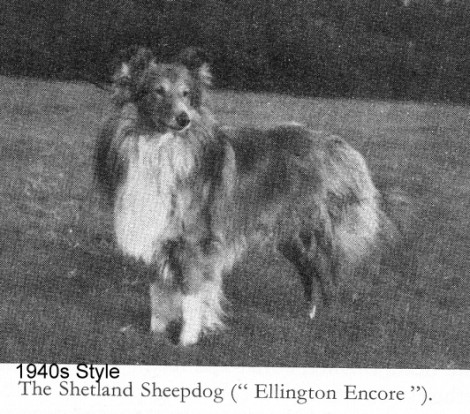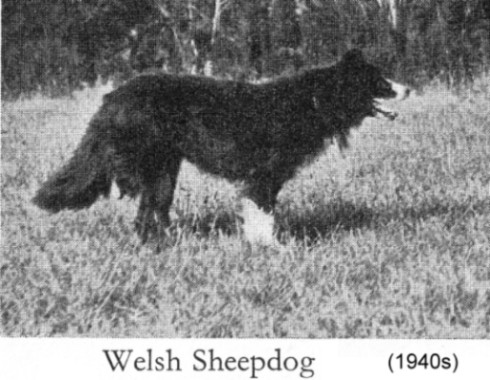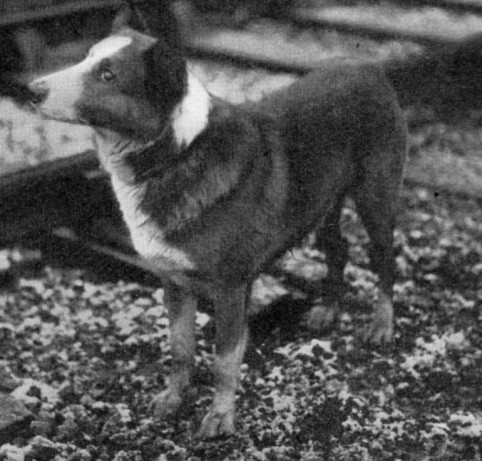
|
OLD SHEEPDOG BREEDS |
 |
THE CUMBERLAND SHEEPDOG
Dogs In Britain, A Description of All native Breeds and Most Foreign Breeds in Britain by Clifford LB Hubbard, 1948:
Not much is heard of this breed nowadays although it has been in the north of England for a very considerable time. From the Peak district to the Cheviots, particularly on the eastern side, the Cumberland Sheepdog has been known as a fine working breed. The late Lord Lonsdale was a great admirer of the breed and owned many in his time. Cumberland Sheepdogs had been in his family for more than a hundred years, and it is certain that no man did as much as he for the breed. He had tried hard to save it from extinction, but in 1899 had to outcross with the German Shepherd Dog; this rescued the race for the time being but a few years ago Lord Lonsdale had disbanded his kennel and given his Cumberlands to farmer friends around Lowther. Cumberland farmers have entered this breed in Sheepdog Trials for at least sixty-five years, indeed, many of the so-called Border Collies which have won awards have really been Cumberland Sheepdogs.
In general the breed is much like the Welsh Sheepdog and old working Collie types, and works quietly, quickly and low-to-ground. The head is rather broad and flat, tapering to a muzzle of medium length, with ears falling over to the front or semi-erect and rather small. The body is fairly long and extremely lithe, with light though muscular legs and a low-set tail carried at the trail. The coat is fairly heavy and quite dense, and coloured black with white blaze, chest, feet and tip of tail. In height it is about 20 inches, and its weight ranges from 40-50 pounds.
THE SHETLAND SHEEPDOG (1940s-Style)
 |
At around 15 inches, these were taller than the modern Shetland Sheepdog and had a less fluffy coat. The modern Shetland Sheepdog in the UK is 14 - 14.5 inches for show dogs, with many pets being no more than 12 inches. The fluffier coat on the modern pet/show Shetland Sheepdogs demonstrates the divergence of working lines and pet/show lines.
The ideal heights of Shetland Sheepdogs has long been a matter of debate. The Scottish Shetland Collie Club (1909) called for 12 inches and this was interpreted as the maximum height. Those shown at Crufts in 1911 were 10-12 inches. Between 1913 and 1914, the Scottish and English Shetland Collie Clubs both set the ideal height as 12 inches. By 1923, 12 - 15 inches was permitted. In the USA today, 13 - 16 inches is permitted for exhibition quality Shetland Sheepdogs; but in the UK the ideal heights are 14 inches (female) and 14.5 inches (male) and no more than an inch over or under these sizes.
THE WELSH SHEEPDOG
 |
Dogs In Britain, A Description of All native Breeds and Most Foreign Breeds in Britain by Clifford LB Hubbard, 1948:
At one time there existed many sheep-herding dogs peculiar to Wales but to-day the group is decreased to two or three breeds only. The ancient pure breeds of Black-and-Tan-Sheepdog and Welsh Hillman are almost extinct, and the
The type best known in Wales to-day is one mostly descended from the old Black-and-Tan with an infusion of working Collie blood, a breed really common throughout the north and central Welsh counties This breed is frequently entered in the Sheepdog Trials and is renowned for its efficiency, nimbleness of mind and body, its desire to please and its extreme sensitiveness of rebuke. It does not ordinarily work low-to-ground in the showy manner sometimes seen in the work of the working Collies, but is absolutely trustworthy without affectation.
When in the eighteenth century the export of Welsh mutton was one of the principal industries, overland travel was much the cheapest method of sending the sheep out of Wales, and Welsh drovers were very busy on the recognised routes from the mountain grazing lands to the principal English ports with the flocks placed in their charge for sale at the end of their journeys. The drovers would often take with them a half dozen of their Sheepdogs as herders on the narrow roads, guards against highwaymen, and providers of game on the route. The dogs then used would have been the early type of Welsh Sheepdog, one similar to the common breed of Wales to-day but a little higher on the leg and more racily built. These dogs were used to herd pigs and goats as well as sheep across the border so early as the fifteenth century.
Classes for Welsh Sheepdogs are not allotted at dog shows generally and few are exhibited, the breed being purely a working breed. Lately an interest has been taken in the breed with the view of exhibiting it and popularising it as a pet, but great care should be taken that no ‘improvements’ be permitted in the breed for show purposes, as in all breeds originally bred for work exhibition breeding has usually resulted in a refining influence which gradually breeds out the sterling qualities of workmanship. If this should happen to the Welsh Sheepdog it would be a disaster of the first magnitude, as it is an extremely valuable agent of the Welsh farmer. The finest means of exhibiting Welsh Sheepdogs is in their natural medium, the mountain pastures, or the Sheepdog Trials; these were first instituted in Wales in 1873 and came to England in 1876. Advertised Trials attract many of the public, as did the well-known Hyde Park exhibition of Sheepdog skill.
 Brown-and-white "Welsh Collie" |
The head is of moderate length with a perceptible stop (sharper than in the Collie), fairly wide between the ears and flat on the top of the skull; the eyes are usually dark though sometimes ‘wall’ or china coloured (occasionally the eyes are odd in colour, in which case far from being regarded as defective they are valued by the sheep farmers); the ears are small and folded over close to the side of the head; the muzzle is fairly long, and never convex or snipy.
The body is muscular and lissom, with a fairly long back, deep chest (the breed generally works in comparatively high altitudes) of good breadth, and moderately tucked-up loins; the legs are light and of medium length with compact feet and hard pads; the tail reaches to the hocks, set low and carried down usually, though raised when excited.
The coat is of medium length (short on the head and fronts of legs, and longer on the collar, hindquarters and tail), smooth in texture and close-lying. The colours vary in different localities but the most constant is black with white blaze, collar, brisket, feet and tail-tip. This colour is almost uniform throughout Wales. Other colours are all-black, black-and-tan, tricolour, and merle. Height is approximately 18 inches and weight ranges from the rather leggy but lighter built dog of North Wales weighing 35 pounds to the dogs of Glamorganshire and Monmouthshire which are generally about 40-45 pounds.